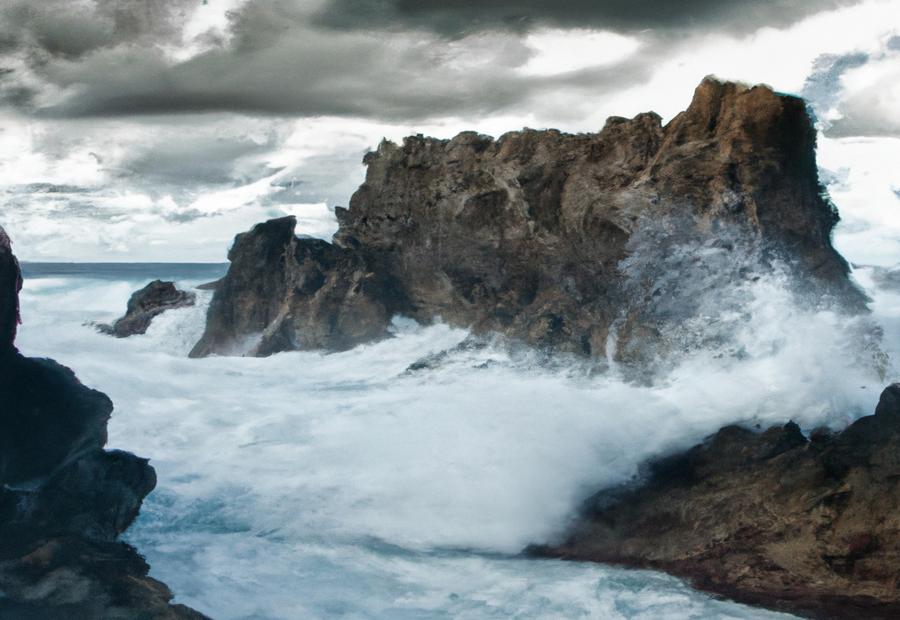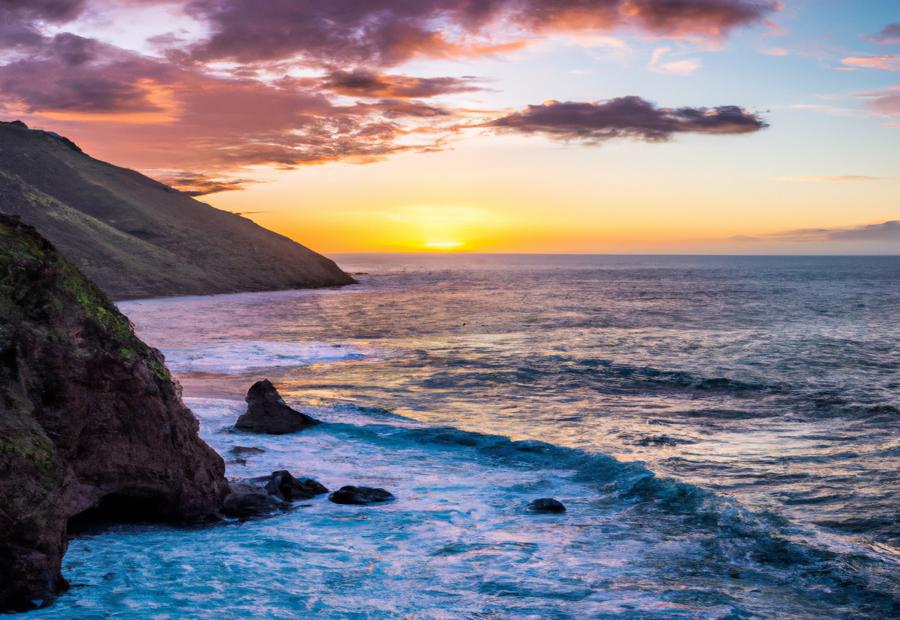Key Takeaways:
- Mouth of the Sea refers to the point where a river meets a larger body of water, such as an ocean or sea. It serves as a crucial junction for various ecological processes and serves as a habitat for diverse species of plants and animals.
- There are different types of river mouths, including deltas, simple river mouths, estuaries, and lagoons. Each type has distinctive characteristics formed by the interaction between river flow, sediment deposition, and oceanic processes.
- River mouths play a significant role in maintaining coastal landforms by facilitating sediment deposition and shaping the coastline. They also provide essential ecosystem services, including flood control, water filtration, and supporting fisheries.
Introduction
Photo Credits: Ktjkrug.Com by Joseph Anderson
River mouths, the meeting point of rivers and oceans, play a crucial role in shaping our planet. From defining landscapes to supporting diverse ecosystems, they hold immense significance. In this section, we will explore the definition and function of river mouths, the various types that exist, and the intriguing formation and characteristics that make each one unique. Through this journey, we’ll unveil the wonders of these natural phenomena and gain a deeper understanding of their importance in our environment.
Definition and Function of River Mouths
River mouths are the points where a river meets a larger body of water. They help to transfer water and sediment. Types of river mouths include deltas, simple river mouths, estuaries, and lagoons.
Deltas form landforms and support ecosystems. Simple river mouths are less complex for sediment deposition. Estuaries mix freshwater and saltwater, creating habitats for species. Lagoons form near a river mouth in coastal areas.
Factors like sediment load, water flow, and geology affect river mouths. Over time, erosion or shifts in sea levels can change them. River mouths provide habitats and serve as breeding grounds.
In addition, they have cultural and economic significance. People use them for fishing, transportation, trade, tourism, and recreation. Industries related to shipping ports or beach tourism thrive near river mouths.
However, human interference and climate change are a threat. Pollution, urban development, and rising sea levels can disrupt river mouths. Conservation is key to preserving their ecology and functions.
Types of River Mouths
River mouths can be classified into different types, such as deltas, simple river mouths, estuaries and lagoons. Let’s explore each one!
Deltas: When a river deposits sediment at its mouth, it forms a fan-shaped landform. It’s characterized by intricate channels and islands created by sediments.
Simple River Mouths: This type is simpler, with only one channel where the river meets the ocean or other body of water.
Estuaries: Where freshwater rivers meet saltwater, it forms an enclosed coastal area with brackish water. It’s home to diverse ecosystems.
Lagoons: Shallow bodies of water, parallel to the coast and separated from the ocean by sandbars or coral reefs. They may be connected to rivers or get their freshwater from rainfall.
Each type of river mouth is unique and plays an important role in our world. They shape coastal landscapes, deposit sediment and support diverse ecosystems. Depending on various factors, there may be more variations.
It’s essential to understand these types of river mouths to appreciate their beauty and significance. Delta – Where rivers have a final identity crisis before merging with the big, salty sea.
Delta
River mouths have a main role in the making and keeping of landforms. A Delta is one example. It is formed when a river empties sediment at its mouth, forming a triangle or fan-like shape. This happens in places with much sediment and minimal tidal or wave energy.
Deltas have an intricate network of streams that branch out from the main river channel. A table can give us information about different types of river mouths, including Deltas. The table shows details like their definition, function, and characteristics. It also outlines their unique triangular or fan-like shape, many distributary channels, and special sediment deposition patterns.
A Delta differs from other river mouths. It has its own features, like its shape, many channels, and the sediment that creates habitats for different ecosystems. This makes Deltas important for preservation of biodiversity and to help plants and animals. They are also vital for the growth and maintenance of landforms along coastlines, and guard against erosion from waves and tides.
Why bother with fancy stuff when a plain river mouth is good enough – like a regular black coffee in a world of frappuccinos.
Simple River Mouth
- A simple river mouth is distinguished by a single channel linking the river to the sea, without any landforms or features such as deltas, estuaries, or lagoons.
- It is unlike other river mouths, lacking complex formations and extensive sediment deposits.
- The simplicity of this type of river mouth makes it less vulnerable to environmental disturbances and human activities.
- Simple river mouths still have an important role in keeping coastal regions healthy and functioning, despite their lack of intricate ecosystems and sedimentation.
Let’s venture into the depths of estuaries and explore their unique complexities!
Estuary
Estuaries are where rivers meet the sea, with a jumble of fresh and salty waters. They are essential ecosystems that provide shelter, food and beneficial growth conditions for a variety of aquatic life. Plus, estuaries filter pollutants and nutrients, helping to improve water quality. The mix of freshwater and saltwater also creates different habitats, like marshes, mudflats and tidal creeks, which are home to many plants and animals. Furthermore, estuaries act as a rest stop for migratory birds.
Estuaries boast distinct physical features, such as shallow depths and slow-moving currents. Often, there are salt marshes or mangrove forests at the edges that prevent erosion and offer habitats. Estuaries come in all sizes from tiny bays to massive bodies like the Chesapeake Bay.
To keep estuaries healthy, it’s important to practice sustainable management. We should reduce human interference like pollution, too much dredging, and destruction of habitats due to urban development. Additionally, we should work to reduce climate change impacts by cutting down on greenhouse gas emissions and adapting to rising sea levels.
Through regulations, public awareness, protected areas and other measures, we can protect estuaries and their valuable cultural and recreational resources for future generations. It’s almost like a lagoon full of mischievous mermaids – unpredictable but worth preserving!
Lagoon
Lagoon: A type of river mouth with a shallow body of water, separated from the open sea by a barrier island or reef. It forms when sediment accumulates along the coast.
Lagoon Table:
- Type: Lagoon
- Formation: Accumulation of sediment along the coastline
- Characteristics:
- – Shallow, partially enclosed body of water
- – Separated from the open sea by a barrier island or reef
- – Calm and brackish waters
- – Mouth of the Sea
Unique Details: Lagoons are found in areas where rivers meet the sea and in low-energy environments like sheltered coastlines or behind sandbars. They provide habitat for various species, including fish, birds, and plants. Also, they act as nurseries for aquatic organisms.
True History: Lagoon concept dates back thousands of years. Ancient civilizations, like Indus Valley and Egypt, recognized the abundance of resources lagoons provided. People still rely on lagoons for their economic and cultural significance.
Formation and Characteristics of River Mouths
River mouths come in various forms, like deltas, simple river mouths, estuaries, and lagoons.
Deltas are formed when sediment is deposited by the river at its mouth.
Simple river mouths occur when a river meets the ocean without shaping the land.
Estuaries happen when freshwater from a river mixes with saltwater from the ocean.
Lagoons are shallow bodies of water separated from the ocean by sandbars.
River mouths have certain characteristics.
- They are sources of sediment deposition, leading to the formation of islands or shoals.
- These areas are also habitats for species due to the mixing of freshwater and saltwater.
River mouths have cultural and economic importance.
- People have settled in these areas for their fertile soil and access to resources.
- Fishing, trade, transportation, and agriculture are activities that depend on river mouths.
- Indigenous communities rely on them for sustenance and spiritual connections.
Remember to look at the physical and ecological importance of river mouths when studying them!
Importance of River Mouths

Photo Credits: Ktjkrug.Com by George Scott
River mouths are vital hubs of biodiversity, landform creation, and cultural significance. Within this in-depth exploration, we will uncover the captivating ecosystems and abundant biodiversity that thrives in these unique river mouth environments. Additionally, we will unveil the intriguing process of sediment deposition and its impact on landforms. Finally, we will delve into the cultural and economic significance that river mouths hold, shedding light on their importance throughout history and in the present day.
Ecosystems and Biodiversity
River mouths are essential for diverse ecosystems and biodiversity. Freshwater from the river meets saltwater from the sea at these unique habitats. This combination provides a dynamic ecosystem, full of plant and animal species.
The combination of saltwater and freshwater leads to different microhabitats. Marshes, mudflats, and tidal channels form. These all contain different organisms. For example, mangrove forests often form in estuarine river mouths. They provide important breeding grounds and shelter for many marine species. Furthermore, predatory birds and mammals may be attracted by the abundance of fish in river mouths.
These places are also key spawning grounds for many species of fish. The nutrient-rich mix of freshwater and saltwater make it ideal for fish reproduction. This ensures the survival of fish populations and contributes to the overall biodiversity.
River mouths not only support biodiversity, but also maintain coastal ecosystems. Sediment from rivers is deposited at their mouths. This leads to landforms such as deltas and sandbars. These provide protection and habitats for various flora and fauna.
River mouths are incredibly diverse and have huge ecological value. Protecting these areas is essential for preserving biodiversity and keeping our coastal environments healthy.
Sediment Deposition and Landforms
Sediment deposition has a huge effect on forming landforms at river mouths. For example, deltas – fan-shaped areas of fertile land – are formed when sediment builds up. They feature networks of distributaries and boast diverse ecosystems filled with different species.
Estuaries form when freshwater and saltwater mix and deposit sediments at a river’s mouth. These areas are special and provide habitats for many types of animals.
Lagoons are shallow bodies of water, separated from the sea by sandbars or barrier islands, which have been formed by sediment accumulation along coastlines. They are important breeding grounds for marine creatures, and help preserve coastal areas from erosion.
In conclusion, sediment deposition has a big part to play in generating landforms near rivers. It creates different ecosystems, and also helps protect coasts from erosion. Knowing these processes is fundamental for successful conservation and management of these special habitats.
Cultural and Economic Significance
River mouths possess immense cultural and economic worth due to their distinct features and uses. They function as essential transportation paths, providing access to inland spots and stimulating trade and commerce. These areas often contain major ports, which serve as key hubs for foreign shipping and aid local economies through generating employment and promoting growth.
Moreover, river mouths have served as centers of people’s settlements and cultural interchange for many years. They have enabled the creation of lively coastal communities which rely on fishing and other aquatic activities to make a living. These communities bring their own special traditions, languages, and customs, adding to the abundant cultural variety of the regions near river mouths.
Additionally, river mouths are frequently connected with tourism thanks to their picturesque scenery, recreational possibilities, and historical relevance. Many vacationers visit these regions to discover the assorted ecosystems, participate in water-based activities such as sailing or kayaking, or simply admire the natural beauty of these coastal spots. Tourism activities provide a considerable contribution to local economies through direct spending on accommodation, dining, and other services.
The cultural and economic importance of river mouths cannot be underestimated. These natural elements play a critical role in supporting human activities while safeguarding biodiversity and ecological equilibrium. The sustainable management of river mouth ecosystems is essential to secure their continued cultural and economic advantages for existing and future generations.
Challenges and Impacts on River Mouths

Photo Credits: Ktjkrug.Com by Kevin Walker
River mouths face numerous challenges and impacts that have far-reaching consequences. From human interference and environmental concerns to the effects of climate change and rising sea levels, the delicate balance of these ecosystems is under constant threat. This section will explore the significant anthropogenic impacts on river mouths and the ongoing conservation efforts aimed at protecting these vital ecosystems.
Human Interference and Environmental Concerns
Human interference causes major challenges for river mouths. Urban development, farming, and pollution all have a negative effect on the delicate ecosystems around them.
Moreover, altering natural river channels or constructing dams can trap sediment upstream, leading to an increase of sedimentation at the mouths.
Furthermore, agricultural runoff introduces too many nutrients into the rivers, leading to algal blooms and oxygen depletion.
To tackle these issues, conservation efforts are being put in place to reduce human interference in river mouths.
Climate Change and Rising Sea Levels
Climate change has huge impacts on river mouths and rising sea levels. Factors such as melting ice caps and thermal expansion of seawater lead to a rise in sea levels. This affects river mouths, changing their features and tasks, causing issues.
River mouths act as in-between zones of rivers and seas, controlling the flow of freshwater into the marine environment. With higher sea levels, these transition areas become more prone to flooding and saltwater intrusion. This can affect the water salinity and damage the balance of ecosystems in river mouths.
Also, due to the rising sea levels, there is a greater risk of coastal erosion and sediment deposition. River mouths are in charge of carrying sediments from upstream and dropping them in their estuaries or deltas. Higher sea levels can disturb the natural deposition, altering landforms and impacting habitats.
Climate change can also cause changes in precipitation and extreme weather events, impacting river flows. This leads to variations in sediment transport, creating difficulties in managing water resources and keeping ecological integrity.
We need conservation efforts; otherwise, future generations will be left with just a dried-up trickle of a river mouth.
Anthropogenic Impacts and Conservation Efforts
Anthropogenic impacts and conservation efforts are linked when it comes to river mouths. These impacts are the bad effects of human activities on these ecosystems. Conservation efforts are to reduce these impacts. Activities like urbanization, industrialization, and pollution near river mouths harm their ecological health and biodiversity. Physical changes in the landforms can also be caused by human interference.
Conservation efforts play an important role. Measures like sustainable development, reducing pollution, and protected areas are strategies to mitigate anthropogenic impacts. Restoration projects like replanting native plants or reintroducing native species help to preserve the biodiversity and functioning of river mouth ecosystems.
Collaboration is needed to make conservation efforts effective. Governments, scientists, local communities, and NGOs must work together to implement management strategies. With their expertise and resources, it is possible to reduce the negative anthropogenic impacts and conserve river mouths for the future.
Conclusion

Photo Credits: Ktjkrug.Com by Jeremy Brown
The article “Mouth of the Sea” reveals the complexity of the subject. It highlights how this connection between the land and sea influences the ecosystems and environment.
The reference data shows the intricate mechanisms, like the interplay between tides, currents, and sediment transport. These elements contribute to the region’s health and balance.
Moreover, the mouth of the sea is a hotspot for economic and cultural activities, such as fisheries, tourism, and transportation. Therefore, it is essential to manage and preserve these areas for sustainable use.
Furthermore, scientific research and monitoring are needed to understand and mitigate any potential risks or impacts. This will help with informed decision-making and effective conservation measures.
Some Facts About Mouth of the Sea:
- ✅ The mouth of a river is the point where it enters a larger body of water, such as a lake, another river, or the ocean. (Source: National Geographic)
- ✅ River mouths can form deltas, estuaries, or lagoons depending on the coastal and tidal conditions. (Source: Smart Water Magazine)
- ✅ River mouths play a crucial role in the deposition of sediment and the interaction between rivers and larger bodies of water. (Source: A-Z Animals)
- ✅ River mouths can create unique environments that support diverse flora and fauna. (Source: Sea Mouth – Wiktionary)
- ✅ River mouths have cultural and economic significance, acting as ports or harbors and contributing to coastal development. (Source: Wikipedia)
FAQs about Mouth Of The Sea
What is the mouth of the Mississippi River?
The mouth of the Mississippi River is the point where the river flows into the Gulf of Mexico. It forms a delta with sediment deposition, creating various landforms such as sandbars and tie channels.
What are sand bars?
Sand bars are landforms that can be found at the mouth of a river. They are formed by the deposition of coarse sediments carried by the river. Sand bars act as barriers and protect sensitive ecosystems, benefiting from the nutrients deposited by the river.
How do tie channels form?
Tie channels are channels that form at the mouth of a river due to changes in flow conditions. When the flow of a river slows down, it drops the sediment it is carrying, leading to the formation of landforms such as tie channels. Tie channels can alter the geomorphology and ecosystem of the area.
What is ambient motion?
Ambient motion refers to the natural movement of the receiving water where a river flows into. It can include factors such as tides, currents, and the rotation of the Earth. The motion of the ambient water can influence the behavior and sediment transport at the mouth of a river.
What is the cultural influence of river mouths?
River mouths have cultural significance as many towns and cities are founded at these locations. The deposition of sediments and easy access for travel and ports make river mouths attractive for human settlements. In the United Kingdom, many places are named after their positions at the mouths of rivers.
How do climatic changes impact river mouths?
Climatic changes, such as sea level rise associated with climate change, can pose risks to coastal cities located at river mouths. Rising sea levels can increase the risk of flooding in these areas. Additionally, changing climate conditions may affect freshwater inflow and sediment transportation, leading to sediment starvation at the river mouth.

